Performance Analysis of Soft-Switching FSO/THz-RF Dual-Hop AF-NOMA Link Based on Cognitive Radio
Abstract
:1. Introduction
2. System and Channel Models
2.1. Soft-Switching FSO/THz Link
- If , regardless of , the FSO link is activated.
- If , and given previously, regardless of , the FSO link is activated.
- If , and given previously, if , the THz link is activated; if , the hybrid link is outage.
- If , if , the THz link is activated; if , the hybrid link is outage.
2.2. RF Link
3. Performance Analysis
3.1. CR System
3.2. NOMA System
3.3. Outage Probability
4. Numerical Results
5. Conclusions
Author Contributions
Funding
Institutional Review Board Statement
Informed Consent Statement
Data Availability Statement
Conflicts of Interest
References
- Maier, M.; Ebrahimzadeh, A.; Beniiche, A. The Art of 6G (TAO 6G): How to wire Society 5.0 [Invited]. J. Opt. Commun. Netw. 2022, 14, A101–A112. [Google Scholar] [CrossRef]
- Khalighi, M.; Uysal, M. Survey on free space optical communication: A communication theory perspective. IEEE Commun. Surv. Tutor. 2014, 16, 2231–2258. [Google Scholar] [CrossRef]
- Ray, P.; Kumar, N.; Guizani, M. A Vision on 6G-Enabled NIB: Requirements, Technologies, Deployments, and Prospect. IEEE Wirel. Commun. 2021, 28, 120–127. [Google Scholar] [CrossRef]
- Malik, S.; Chung, Y.; Sahu, P. On the performance of a hybrid frequency–phase-keying-based MIMO hybrid RF/FSO communication link. J. Opt. Commun. Netw. 2022, 14, 840–851. [Google Scholar] [CrossRef]
- Li, K.; Yu, J. Photonics-Aided Terahertz-Wave Wireless Communication. J. Light. Technol. 2022, 40, 4186–4195. [Google Scholar] [CrossRef]
- Dang, A. A closed-form solution of the bit-error rate for optical wireless communication systems over atmospheric turbulence channels. Opt. Express 2011, 19, 3494–3502. [Google Scholar] [CrossRef]
- Boulogeorgos, A.; Alexiou, A.; Merkle, T. Terahertz technologies to deliver optical network quality of experience in wireless systems beyond 5G. IEEE Commun. Mag. 2018, 56, 144–151. [Google Scholar] [CrossRef]
- Federici, J.; Ma, J.; Moeller, L. Review of weather impact on outdoor terahertz wireless communication links. Nano Commun. Netw. 2016, 10, 13–26. [Google Scholar] [CrossRef]
- Yahia, O.; Erdogan, E.; Kurt, G. A Weather-Dependent Hybrid RF/FSO Satellite Communication for Improved Power Efficiency. IEEE Wirel. Commun. Lett. 2022, 11, 573–577. [Google Scholar] [CrossRef]
- Li, R.; Dang, A. Multi-user access in wireless optical communication system. Opt. Express 2018, 26, 22658–22673. [Google Scholar] [CrossRef]
- Zhuang, Y.; Zhang, J. Secrecy performance analysis for a NOMA based FSO-RF system with imperfect CSI. J. Opt. Commun. Netw. 2022, 14, 500–510. [Google Scholar] [CrossRef]
- McHenry, M.; Tenhula, P.; McCloskey, D. Chicago spectrum occupancy measurements & analysis and a long-term studies proposal. In Proceedings of the First International Workshop on Technology and Policy for Accessing Spectrum, Boston, MA, USA, 5 August 2006; p. 1. [Google Scholar] [CrossRef]
- Islam, M.; Koh, C.; Oh, S. Spectrum Survey in Singapore: Occupancy Measurements and Analysis. In Proceedings of the 2008 3rd International Conference on Cognitive Radio Oriented Wireless Networks and Communications, Singapore, 15–17 May 2008; p. 1. [Google Scholar] [CrossRef]
- Xue, J.; Feng, Z.; Chen, K. Beijing Spectrum Survey for Cognitive Radio Applications. In Proceedings of the 2013 IEEE 78th Vehicular Technology Conference, Las Vegas, NV, USA, 2–5 September 2013; pp. 1–5. [Google Scholar] [CrossRef]
- Goldsmith, A.; Jafar, S.; Maric, I. Breaking Spectrum Gridlock With Cognitive Radios: An Information Theoretic Perspective. Proc. IEEE 2009, 97, 894–914. [Google Scholar] [CrossRef]
- Kader, M. A power-domain NOMA based overlay spectrum sharing scheme. Future Gener. Comput. Syst. 2020, 105, 222–229. [Google Scholar] [CrossRef]
- Zhu, D.; Pan, S. Broadband Cognitive Radio Enabled by Photonics. J. Light. Technol. 2020, 38, 3076–3088. [Google Scholar] [CrossRef]
- Wang, Y.; Zhan, X.; Zhan, Z. Performance of an all-links MIMO-OSTBC mixed underlay cognitive RF/FSO system. Appl. Opt. 2020, 61, 5489–5495. [Google Scholar] [CrossRef]
- Jee, A.; Janghel, K.; Prakriya, S. Performance of Adapative Multi-User Underlay NOMA Transmission With Simple User Selection. IEEE Trans. Cogn. Commun. 2020, 8, 871–887. [Google Scholar] [CrossRef]
- Varshney, N.; Jagannatham, A.; Varshney, P. Cognitive MIMO-RF/FSO Cooperative Relay Communication With Mobile Nodes and Imperfect Channel State Information. IEEE Trans. Cogn. Commun. 2018, 4, 544–555. [Google Scholar] [CrossRef]
- AI-Qahtani, F.; EI-Malek, A.; Ansari, I. Outage Analysis of Mixed Underlay Cognitive RF MIMO and FSO Relaying With Interference Reduction. IEEE Photonics J. 2017, 9, 7902722. [Google Scholar] [CrossRef]
- Torabi, M.; Mohammadi, N.; Nerguizian, C. Performance analysis of an asymmetric two-hop amplify-and-forward relaying RF-FSO system in a cognitive radio with partial relay selection. Opt. Commun. 2020, 505, 127478. [Google Scholar] [CrossRef]
- Arezumand, H.; Jafarian, H.; Nasab, E. Outage and Diversity Analysis of Underlay Cognitive Mixed RF-FSO Cooperative System. J. Opt. Commun. Netw. 2017, 9, 909–920. [Google Scholar] [CrossRef]
- Arzykulov, S.; Nauryzbayev, G.; Tsiftsis, T. Performance Analysis of Underlay Cognitive Radio Nonorthogonal Multiple Access Networks. IEEE Trans. Veh. Technol. 2019, 68, 9318–9322. [Google Scholar] [CrossRef]
- Bae, J.; Han, Y. Joint Power and Time Allocation for Two-Way Cooperative NOMA. IEEE Trans. Veh. Technol. 2019, 68, 12443–12447. [Google Scholar] [CrossRef]
- Kumar, V.; Ding, Z.; Flanagan, M. On the Performance of Downlink NOMA in Underlay Spectrum Sharing. IEEE Trans. Veh. Technol. 2021, 70, 4523–4540. [Google Scholar] [CrossRef]
- Wang, Z.; Shi, W.; Liu, W. Performance analysis of mixed RF/FSO system with spatial diversity. Opt. Commun. 2019, 443, 230–237. [Google Scholar] [CrossRef]
- Li, S.; Yang, L. Performance analysis of dual-hop THz transmission systems over α-μ fading channels with pointing errors. IEEE Internet Things 2021, 14, 11772–11783. [Google Scholar] [CrossRef]
- Li, S.; Yang, L.; Zhang, J. Mixed THz/FSO Relaying System: Statistical Analysis and Performance Evaluation. IEEE Trans. Wirel. Commun. 2022, 21, 10996–11010. [Google Scholar] [CrossRef]
- Wolfram. The Wolfram Functions Site. 2001. Available online: https://functions.wolfram.com/ (accessed on 31 August 2023).
- Singya, P.; Makki, B.; Errico, A. Hybrid FSO/THz-Based Backhaul Network for mmWave Terrestrial Communication. IEEE Trans. Wirel. Commun. 2023, 22, 4342–4359. [Google Scholar] [CrossRef]
- Men, J.; Ge, J.; Zhang, C. Performance Analysis of Nonorthogonal Multiple Access for Relaying Networks over Nakagami-m Fading Channels. IEEE Trans. Veh. Technol. 2017, 66, 1200–1208. [Google Scholar] [CrossRef]
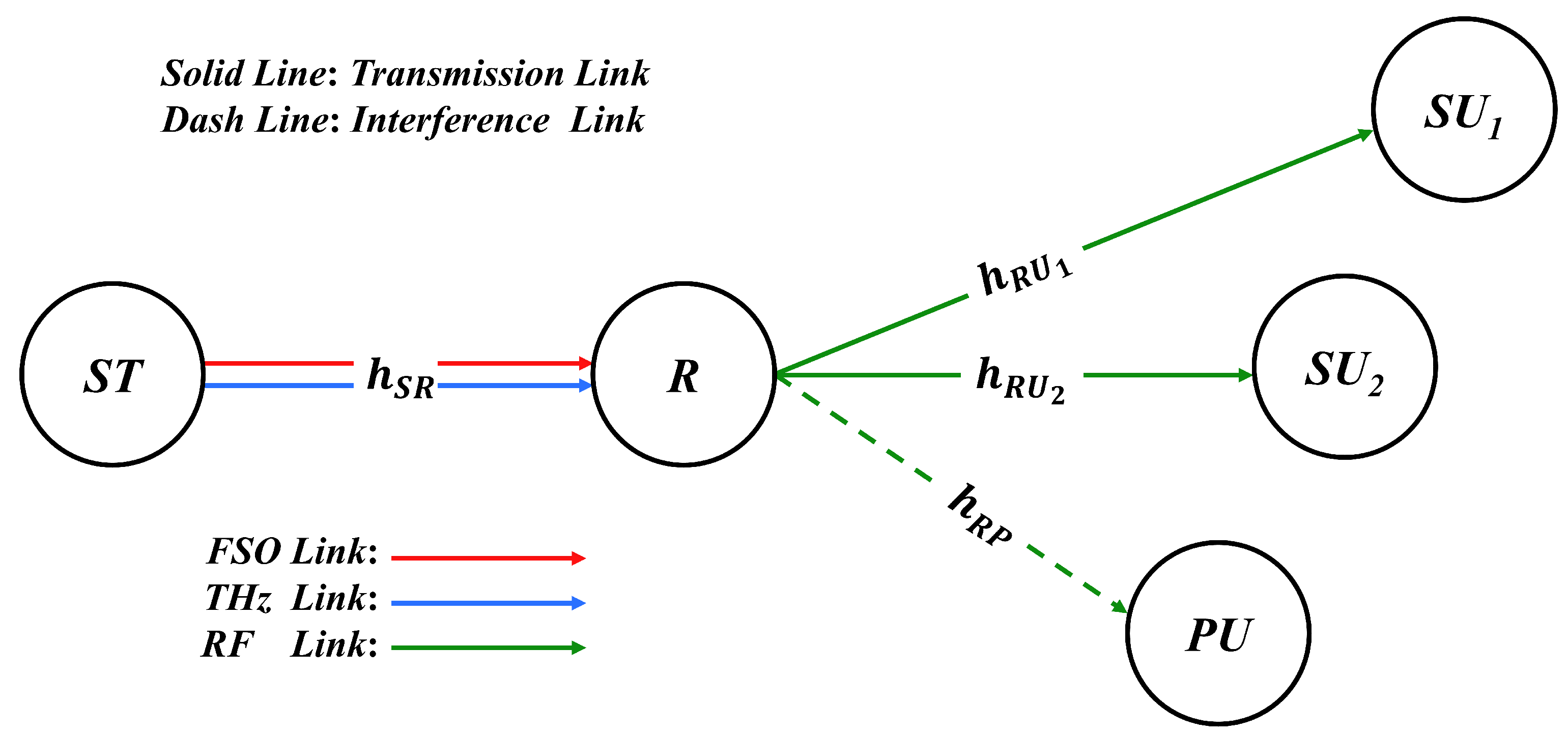

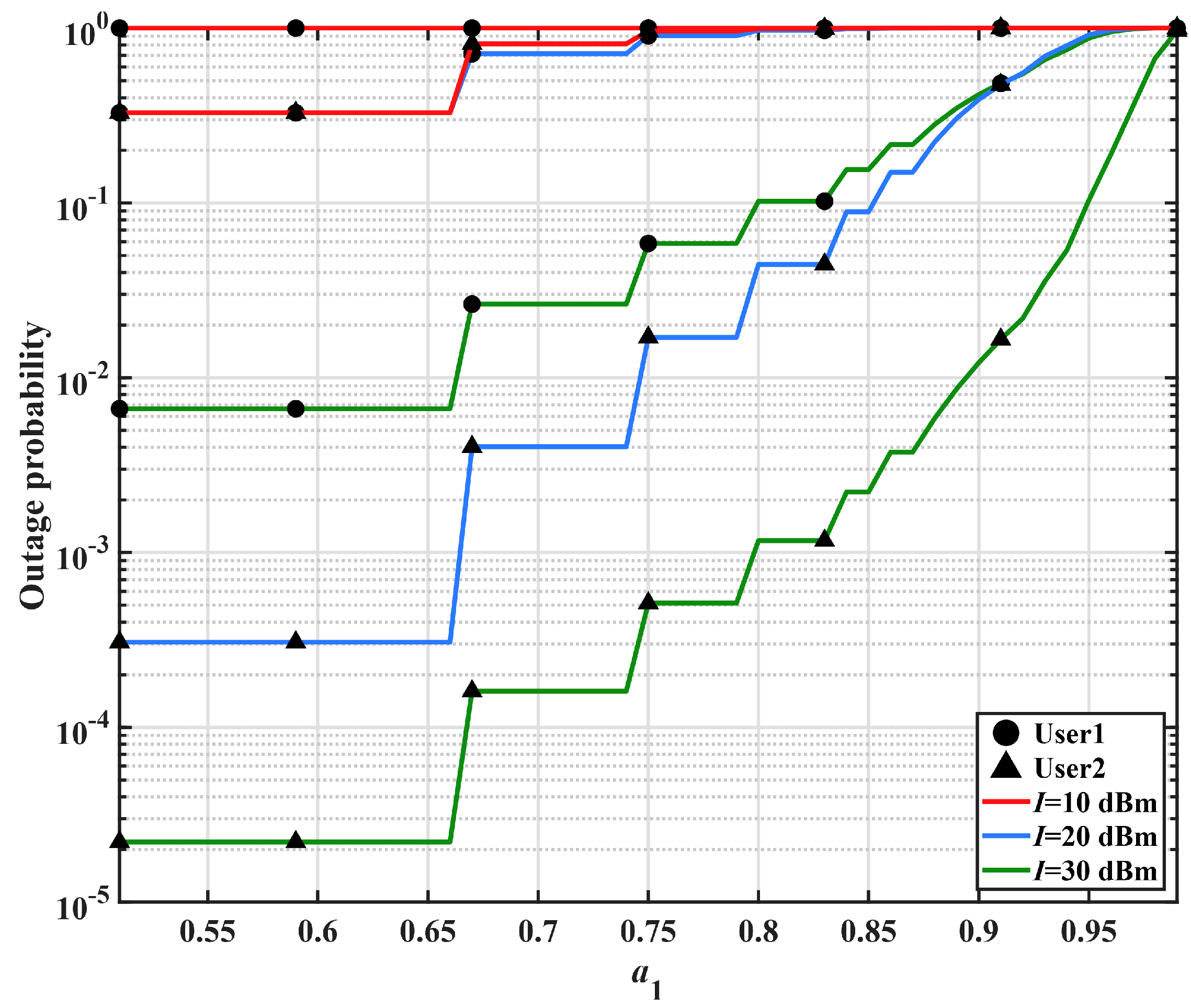
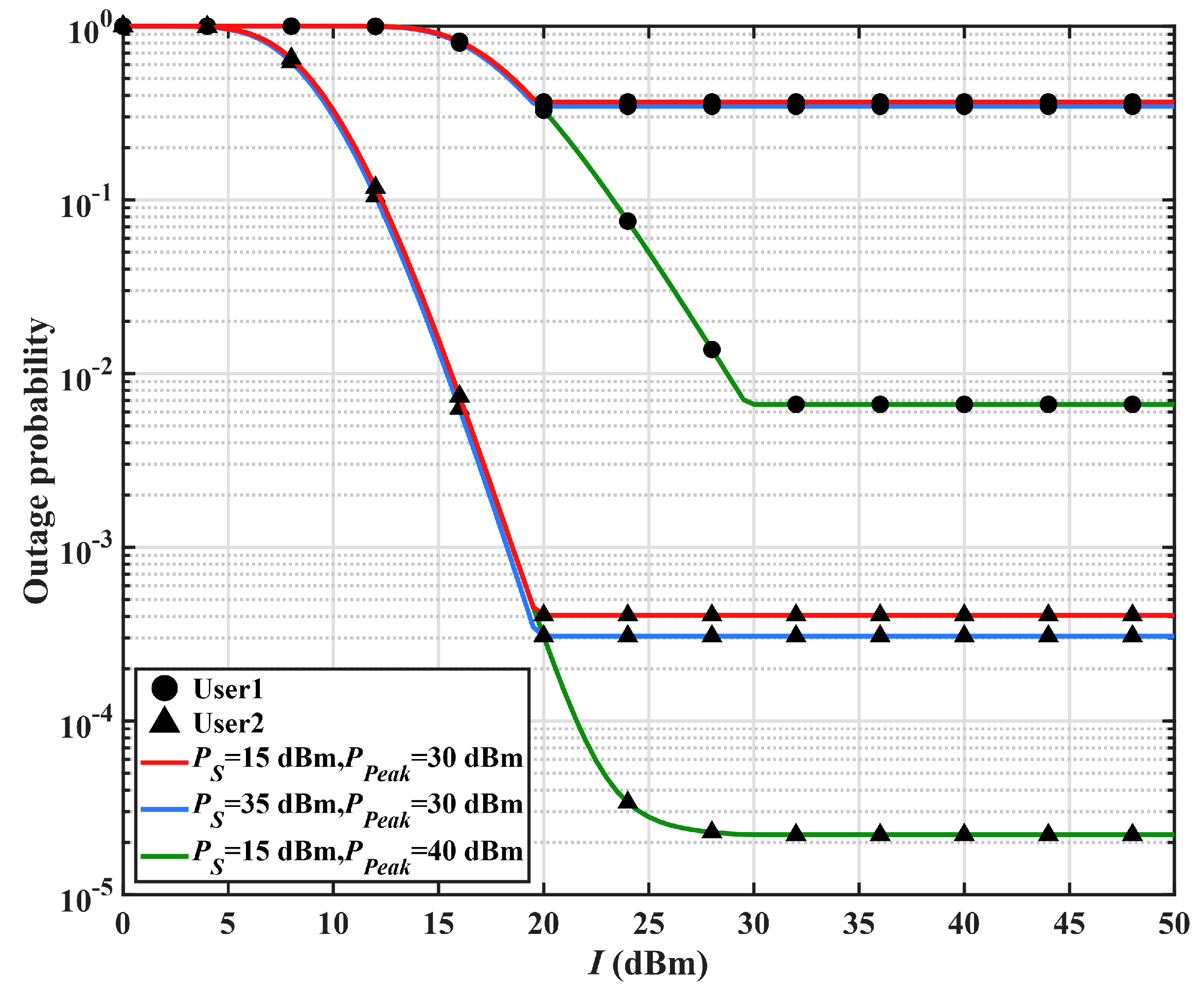

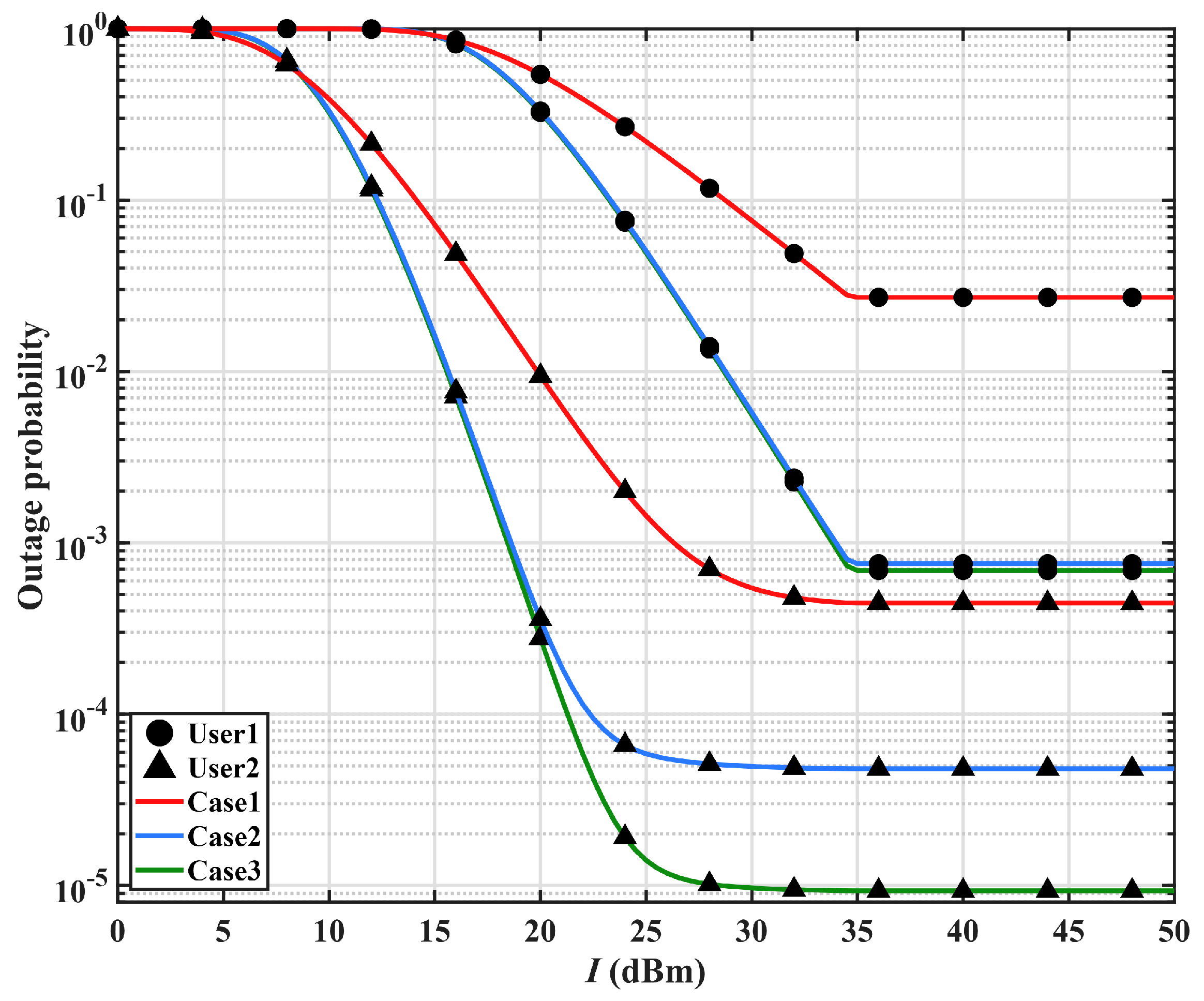
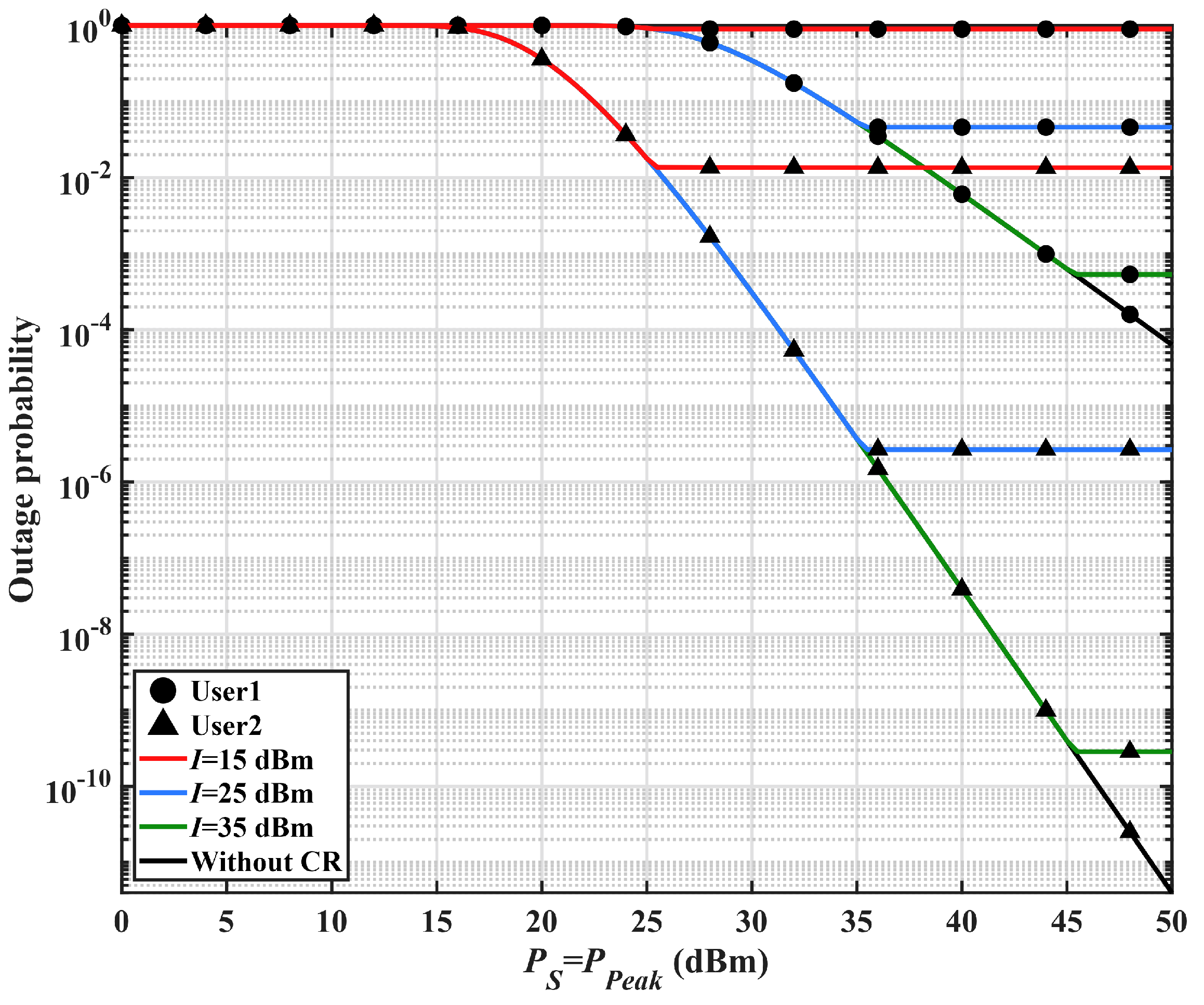
Disclaimer/Publisher’s Note: The statements, opinions and data contained in all publications are solely those of the individual author(s) and contributor(s) and not of MDPI and/or the editor(s). MDPI and/or the editor(s) disclaim responsibility for any injury to people or property resulting from any ideas, methods, instructions or products referred to in the content. |
© 2023 by the authors. Licensee MDPI, Basel, Switzerland. This article is an open access article distributed under the terms and conditions of the Creative Commons Attribution (CC BY) license (https://creativecommons.org/licenses/by/4.0/).
Share and Cite
Liu, R.; Wang, Z.; Wang, X.; Lu, J.; Wang, Y.; Zhuo, Y.; Wu, R.; Wei, Z.; Liu, H. Performance Analysis of Soft-Switching FSO/THz-RF Dual-Hop AF-NOMA Link Based on Cognitive Radio. Photonics 2023, 10, 1086. https://doi.org/10.3390/photonics10101086
Liu R, Wang Z, Wang X, Lu J, Wang Y, Zhuo Y, Wu R, Wei Z, Liu H. Performance Analysis of Soft-Switching FSO/THz-RF Dual-Hop AF-NOMA Link Based on Cognitive Radio. Photonics. 2023; 10(10):1086. https://doi.org/10.3390/photonics10101086
Chicago/Turabian StyleLiu, Rongpeng, Ziyang Wang, Xuerui Wang, Jingwei Lu, Yawei Wang, Yizhou Zhuo, Ruihuan Wu, Zhongchao Wei, and Hongzhan Liu. 2023. "Performance Analysis of Soft-Switching FSO/THz-RF Dual-Hop AF-NOMA Link Based on Cognitive Radio" Photonics 10, no. 10: 1086. https://doi.org/10.3390/photonics10101086





